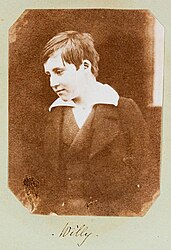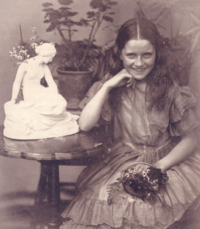

A smile is a facial expression formed primarily by flexing the muscles at the sides of the mouth. Some smiles include a contraction of the muscles at the corner of the eyes, an action known as a Duchenne smile. Among humans, a smile expresses delight, sociability, happiness, joy, or amusement. It is distinct from a similar but usually involuntary expression of anxiety known as a grimace. Although cross-cultural studies have shown that smiling is a means of communication throughout the world, there are large differences among different cultures, religions, and societies, with some using smiles to convey confusion, embarrassment or awkwardness.
Evolutionary background
Primatologist Signe Preuschoft traces the smile back over 30 million years of evolution to a "fear grin" stemming from monkeys and apes, who often used barely clenched teeth to portray to predators that they were harmless or to signal submission to more dominant group members. The smile may have evolved differently among species, especially among humans.
Social effects
Smiling seems to have a favorable influence upon others and makes one likable and more approachable. In the social context, smiling and laughter have different functions in the order of sequence in social situations:
- Smiling is sometimes a pre-laughing device and is a common pattern for paving the way to laughter;
- Smiling can be used as a response to laughter.
Smiling is a signaling system that evolved from a need to communicate information in many different forms. One of these is an advertisement of sexual interest. Female smiles are appealing to heterosexual males, increasing physical attractiveness and enhancing sex appeal. However, recent research indicates a man's smile may or may not be most effective in attracting heterosexual women, and that facial expressions such as pride or even shame might be more effective. The researchers did not explicitly study the role of smiles in other sexual preferences.
As reinforcement and manipulation
The influence of smiling on others is not necessarily benign. It may take the form of positive reinforcement, possibly for an underhand manipulative and abusive purpose.
Cultural differences
While smiling is perceived as a positive emotion most of the time, there are many cultures that perceive smiling as a negative expression and consider it unwelcoming. Too much smiling can be viewed as a sign of shallowness or dishonesty. In some parts of Asia, people may smile when they are embarrassed or in emotional pain. Some people may smile at others to indicate a friendly greeting. A smile may be reserved for close friends and family members. Many people in the former Soviet Union area consider smiling at strangers in public to be unusual and even suspicious behavior, or even a sign of stupidity.
Systematic large cross-cultural study on social perception of smiling individuals documented that in some cultures a smiling individual may be perceived as less intelligent than the same non-smiling individual (and that cultural uncertainty avoidance may explain these differences). Furthermore, the same study showed that corruption at the societal level may undermine the prosocial perception of smiling—in societies with high corruption indicators, trust toward smiling individuals is reduced.
There can also be gender differences. In the United States and Canada, women report men telling them to smile. For example, Greg Rickford, a member of the Canadian Parliament told a female journalist to smile rather than answer the question she had asked. Biological anthropologist Helen Fisher states that, while this could be either caring or controlling behavior, such behavior is unlikely to be welcome.
-
 Smiling Girl, a Courtesan, Holding an Obscene Image (1625) by Gerard van Honthorst. Humor has been noted as a source of inspiration for many notable Dutch Golden Age painters.
Smiling Girl, a Courtesan, Holding an Obscene Image (1625) by Gerard van Honthorst. Humor has been noted as a source of inspiration for many notable Dutch Golden Age painters.
-
 In her Self-portrait with her daughter Julie (1786), Élisabeth Vigée Le Brun painted herself smiling. When it was exhibited at the Salon of 1787, the court gossip-sheet Mémoires secrets commented: "An affectation which artists, art-lovers and persons of taste have been united in condemning, and which finds no precedent among the Ancients, is that in smiling, shows her teeth."
In her Self-portrait with her daughter Julie (1786), Élisabeth Vigée Le Brun painted herself smiling. When it was exhibited at the Salon of 1787, the court gossip-sheet Mémoires secrets commented: "An affectation which artists, art-lovers and persons of taste have been united in condemning, and which finds no precedent among the Ancients, is that in smiling, shows her teeth."
-
 A photograph of Welsh boy, William Mansel (1838-1866) titled 'Willy', smiling at something off camera. Taken c. 1853, it is the earliest known photograph of a smile.
A photograph of Welsh boy, William Mansel (1838-1866) titled 'Willy', smiling at something off camera. Taken c. 1853, it is the earliest known photograph of a smile.
-
 Photograph taken by Lewis Carroll titled "No Lessons Today" (1863), depicting a child's feelings when school holidays begin. Carroll later sent the photograph to Charles Darwin for possible use in his publication The Expression of the Emotions in Man and Animals.
Photograph taken by Lewis Carroll titled "No Lessons Today" (1863), depicting a child's feelings when school holidays begin. Carroll later sent the photograph to Charles Darwin for possible use in his publication The Expression of the Emotions in Man and Animals.
-
 In the late 19th century and early 20th century, photographs taken in the United Kingdom rarely depicted people smiling, in accordance with the cultural conventions of Victorian and Edwardian society. In contrast, the photograph Eating Rice, China depicts a smiling Chinese man.
In the late 19th century and early 20th century, photographs taken in the United Kingdom rarely depicted people smiling, in accordance with the cultural conventions of Victorian and Edwardian society. In contrast, the photograph Eating Rice, China depicts a smiling Chinese man.
Dimples

Cheek dimples are formed secondary to a bifid zygomaticus major muscle, whose fascial strands insert into the dermis and cause a dermal tethering effect. Dimples are genetically inherited and are a dominant trait. Having bilateral dimples (dimples in both cheeks) is the most common form of cheek dimples. A rarer form is the single dimple, which occurs on one side of the face only.
This bifid variation of the muscle originates as a single structure from the zygomatic bone. As it travels anteriorly, it then divides with a superior bundle that inserts in the typical position above the corner of the mouth. An inferior bundle inserts below the corner of the mouth. Dimples are analogous and how they form in cheeks varies from person to person. The shape of a person's face can affect the look and form as well: leptoprosopic (long and narrow) faces have long and narrow dimples, and eryprosopic (short and broad) faces have short, circular dimples. People with a mesoprosopic face are more likely to have dimples in their cheeks than any other face shape.
Duchenne smile

While conducting research on the physiology of facial expressions in the mid-19th century, French neurologist Guillaume Duchenne identified two distinct types of smiles. A Duchenne smile involves contraction of both the zygomatic major muscle (which raises the corners of the mouth) and the orbicularis oculi muscle (which raises the cheeks and forms crow's feet around the eyes). The Duchenne smile has been described as "smizing", as in "smiling with the eyes". An exaggerated Duchenne smile is sometimes associated with lying.
Non-Duchenne smile
A non-Duchenne smile involves only the zygomatic major muscle. According to Messenger et. al. "Research with adults initially indicated that joy was indexed by generic smiling, any smiling involving the raising of the lip corners by the zygomatic major .... More recent research suggests that smiling in which the muscle around the eye contracts, raising the cheeks high (Duchenne smiling), is uniquely associated with positive emotion."
The "Pan Am smile", also known as the "Botox smile", is the name given to a fake smile, in which only the zygomatic major muscle is voluntarily contracted to show politeness. It is named after the now-defunct airline Pan American World Airways, whose flight attendants would always flash every passenger the same perfunctory smile. Botox was introduced for cosmetic use in 2002. Chronic use of Botox injections to deal with eye wrinkles can result in paralysis of the small muscles around the eyes, preventing the appearance of a Duchenne smile.
Other animals

In other animals, the baring of teeth is often used as a threat or warning display—known as a snarl—or a sign of submission. For chimpanzees, it can also be a sign of fear. However, not all animal displays of teeth convey negative acts or emotions. For example, Barbary macaques demonstrate an open mouth display as a sign of playfulness, which likely has similar roots and purposes as the human smile.
See also
References
- Izard, Carroll E. (1971). The Face of Emotion. New York: Appleton-Century-Croft. ISBN 978-0-390-47831-3.frown
- Parr, L. A.; Waller, B. M. (2006). "Understanding chimpanzee facial expression: Insights into the evolution of communication". Social Cognitive and Affective Neuroscience. 1 (3): 221–228. doi:10.1093/scan/nsl031. PMC 2555422. PMID 18985109. Retrieved 2022-05-07.
- Inglis-Arkell, Esther (7 October 2013). "Why do we smile and laugh when we're terrified?". Gizmodo. Retrieved 7 October 2016.
- Gladstone, G. (2002). "When you're smiling, does the whole world smile for you?". Australasian Psychiatry. 10 (2): 144–146. doi:10.1046/j.1440-1665.2002.00423.x. S2CID 145551014.
- Haakana, M. (2010). "Laughter and smiling: Notes on co-occurrences". Journal of Pragmatics. 42 (6): 1499–1512. doi:10.1016/j.pragma.2010.01.010.
- Tracy, Jessica L.; Beall, Alec T. (2011). "Happy Guys Finish Last: The Impact of Emotion Expressions on Sexual Attraction" (PDF). Emotion. 11 (6): 1379–1387. doi:10.1037/a0022902. PMID 21604870. Archived from the original (PDF) on 2011-06-26.
- Braiker, Harriet B. (2004). Who's Pulling Your Strings ? How to Break The Cycle of Manipulation. McGraw Hill Professional. ISBN 978-0-07-144672-3.
- Charles Tidwell. "Non Verbal Communication". Andrews.edu. Retrieved 2014-04-22.
- "Nonverbal Communication". Rpi.edu. Retrieved 2014-04-22.
- Gorvett, Zaria (10 April 2017). "There are 19 types of smile but only six are for happiness". BBC Future.
- Krys, Kuba; -Melanie Vauclair, C.; Capaldi, Colin A.; Lun, Vivian Miu-Chi; Bond, Michael Harris; Domínguez-Espinosa, Alejandra; Torres, Claudio; Lipp, Ottmar V.; Manickam, L. Sam S. (June 2016). "Be Careful Where You Smile: Culture Shapes Judgments of Intelligence and Honesty of Smiling Individuals". Journal of Nonverbal Behavior. 40 (2): 101–116. doi:10.1007/s10919-015-0226-4. ISSN 0191-5886. PMC 4840223. PMID 27194817.
- Laing, Sarah (July 25, 2018). "Why Do Men Need Women To Smile?". Flare. Archived from the original on 2020-10-01. Retrieved 2020-09-22.
- May, Ashley (March 2017). "Why you shouldn't tell a woman to smile". USA Today. Retrieved 2020-09-22.
- Siegal, Nina (October 21, 2017). "Need a Good Laugh? Check Out Some 17th-Century Dutch Art". The New York Times. Retrieved October 20, 2023.
- Jones, Colin (2003). The Great Nation: France from Louis XIV to Napoleon. London: Penguin Books. p. 364. ISBN 9780140130935.
- https://www.library.wales/discover-learn/digital-exhibitions/photographs/early-swansea-photography/welsh-pioneers/%7Ctitle=Swansea in the nineteenth century, Welsh Pioneers.
- "The first smile and photobomb ever photographed". 18 September 2015.
- Wakeling, Edward (2014). Lewis Carroll: The Man and his Circle. I.B. Tauris. p. 164. ISBN 978-1780768205.
- Edwards, Phil (7 October 2016). "Why people never smiled in old photographs". Vox.
- Lari, A. R.; Panse, Nikhil (January 2012). "Anatomical basis of dimple creation - A new technique: Our experience of 100 cases". Indian Journal of Plastic Surgery. 45 (1): 89–93. doi:10.4103/0970-0358.96593. ISSN 1998-376X. PMC 3385407. PMID 22754160.
- Chalathadka, Mahabaleshwara; Shankar, K Kiruba; Lakshmi, G Vijaya; Nithin, VM; Kulkarni, Sneha; Firdousbano, Mulla (2019). "Evaluation of Prevalence and Morphology of Dimple among Population of Sullia Taluk". Journal of Cutaneous and Aesthetic Surgery. 12 (4): 227–230. doi:10.4103/JCAS.JCAS_109_19. ISSN 0974-2077. PMC 6967164. PMID 32001967.
- ^ Almaary, Hayaat F.; Scott, Cynthia; Karthik, Ramakrishnan (2018). "New Landmarks for the Surgical Creation of Dimples Based on Facial Form". The Journal of Clinical and Aesthetic Dermatology. 11 (5): 22–26. PMC 5955629. PMID 29785234.
- Davis, Darryl (2014-05-30). How to Design a Life Worth Smiling About: Developing Success in Business and in Life. McGraw Hill Professional. p. 8. ISBN 9780071819879. (Subscription required.)
- "How facial software can identify liars". The Week UK. 24 May 2018.
- Duchenne, Guillaume (1990). The Mechanism of Human Facial Expression. New York: Cambridge University Press. Translated by R. Andrew. Originally published as Mecanisme de la Physionomie Humaine in 1862.
- Messinger, D. S.; Fogel, A.; Dickson, K. (2001). "All smiles are positive, but some smiles are more positive than others". Developmental Psychology. 37 (5): 642–653. CiteSeerX 10.1.1.502.9428. doi:10.1037/0012-1649.37.5.642. PMID 11552760.
- Harlow, John (February 20, 2005). "The smile that says where you're from". The Sunday Times. Archived from the original on Jun 29, 2011. Retrieved 18 January 2011.
- Fischer, Andrea (11 September 2013). "FDA approves Botox Cosmetic to improve the appearance of crow's feet lines". FDA. Archived from the original on Nov 8, 2013. Retrieved 3 November 2013.
- Preuschoft, Signe (1992). "'Laughter' and 'Smile' in Barbary Macaques (Macaca Sylvanus)". Ethology. 91 (3): 220–36. doi:10.1111/j.1439-0310.1992.tb00864.x.
Further reading
- Conniff, Richard (2007). "What's behind a smile?". Smithsonian Magazine. 38: 46–53.
- Ottenheimer, H.J. (2006). The anthropology of language: An introduction to linguistic anthropology. Belmont, CA: Thomson Wadsworh. ISBN 978-1111828752
- Ekman, P.; Davidson, R.J.; Friesen, W.V. (1990). "The Duchenne smile: Emotional expression and brain psysiology II". Journal of Personality and Social Psychology. 58 (2): 342–353. doi:10.1037/0022-3514.58.2.342. PMID 2319446. Cited in: Russell and Fernandez-Dols, eds. (1997).
- Russell and Fernandez-Dols, eds. (1997). The Psychology of Facial Expression. Cambridge. ISBN 0-521-58796-4.